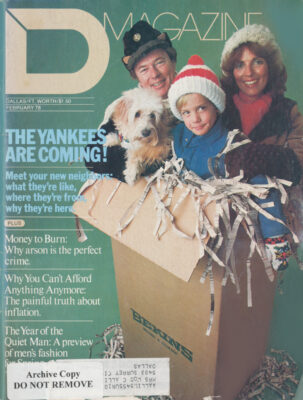hile I was salivating my way through the World of Foods at this year’s State Fair of Texas, the Art Deco grandeur of the place finally hit me.
Most Dallasites see the fairgrounds at least once a year. Many of us scaled those deco walls and carved the initials of our momentary true loves in the painted deco frescoes. And many of us stared, as awaking youth, at the nubile bare-breasted statues that adorn the lagoon.
Deco. The first world-wide trend in design to take Dallas by storm. And where is it now? Covered with knotty pine panelling, ornamental iron, and harvest gold paint. The wonderful old WFAA station is a parking lot.
But in 1936, during the Texas Centennial, deco was the thing. On the heels of Art Nou-veau, Bauhaus and De Stijl, Art Deco combined Fauvism, Cubism, and the vogue for Egyptian and Mayan art. It also represented the full acceptance of the machine age, and the abandoning of the traditional barriers between fine and applied art. The name came from an exhibit in Paris in 1925, the Exposition Internationale des Arts Decoratifs et Industriels Modernes.
The works in the exposition featured heavy geometric patterns and simple decoration. The style was snapped up by Hollywood, where the streamlined look, more elegant in black and white than in color, was made a hot trend. Vast surfaces of metal and glass allowed the simplest of rooms to be transformed with a minimum of accessories. What you left out became more important than what you put in.
For the first time anyone could be a designer. All you needed was a ruler and a compass and a pencil to create your own deco motifs. Streamlining became a way of life.
Dallas, still a young city, had little time for trendy ideas, but the utilitarian and the functional aspects of deco caught the city’s fancy. Unfortunately, the deco craze was nipped in the bud five years after the Centennial with the coming of the war. But not until after a few forward-thinking designers had talked some of the utilities, a couple of radio stations and insurance companies into going with the cultural flow.
If you still believe in deco today, you’ll have to have a passion for it. Your search for it will take you downtown, into the old garment district (did you even know there was a garment district?) around Jackson and Austin near Lamar. Highland Park also had some deco desperados who strived for culture shock. And many of the old Interstate theaters, like the Lakewood and the Village, have jazzy motifs that qualify as deco.
Ironically, the prevalent style of building in Dallas today, the giant mirrored glass, steel and chrome structures like Campbell Centre and Reunion, have their roots in the Art Deco tradition. So by doing away with the old and bringing in the new, Dallas is finally catching up with a 50-year-old trend.
Related Articles

Arts & Entertainment
Dallas College is Celebrating Student Work for Arts Month
The school will be providing students from a variety of programs a platform to share their work during its inaugural Design Week and a photography showcase at the Hilton Anatole.
By Austin Zook

Basketball
A Review of Some of the Shoes (And Performances) in Mavs-Clippers Game 1
An excuse to work out some feelings.
By Zac Crain

Home & Garden
Past in Present—A Professional Organizer Shows You How To Let Go
A guide to taming emotional clutter.
By Jessica Otte


